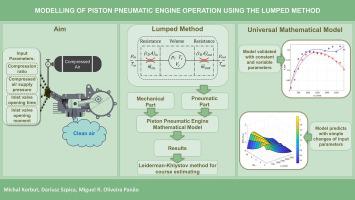当前位置:
X-MOL 学术
›
Energy Convers. Manag.
›
论文详情
Our official English website, www.x-mol.net, welcomes your feedback! (Note: you will need to create a separate account there.)
Modelling of piston pneumatic engine operation using the lumped method
Energy Conversion and Management ( IF 10.4 ) Pub Date : 2024-03-16 , DOI: 10.1016/j.enconman.2024.118310 Michał Korbut , Dariusz Szpica , Miguel R. Oliveira Panão
Energy Conversion and Management ( IF 10.4 ) Pub Date : 2024-03-16 , DOI: 10.1016/j.enconman.2024.118310 Michał Korbut , Dariusz Szpica , Miguel R. Oliveira Panão

|
In recent years, a significant increase in interest in alternative vehicle power sources has become apparent. Beyond the primary trend, electric drives, there can also be distinguished much less frequently considered pneumatic drives. One could partly attribute the low popularity of pneumatic drives to the relatively low energy density of compressed air, which negatively affects the achieved performance. The study presented focuses on developing a computational model of a piston pneumatic engine, which enables the analysis of the impact of parameters such as engine compression ratio, compressed air supply pressure, inlet valve opening time, and inlet valve opening moment in relation to TDC, on its energy and economic indicators. The object of research is an internal combustion engine from a moped converted to operate with compressed air. The modelling approach has two parts: mechanical and pneumatic. The second part uses the lumped method because of the ability to model complex elements with idealized finite elements corresponding to concentrated volumes and resistances. The engine performance analysis includes the parametric influence of the compression ratio, supply pressure, inlet valve opening angle in relation to crankshaft rotation, and total inlet valve opening time on the torque, power, and mass flow rate of air supplied to the engine. The Brake Specific Air Consumption parameter values, equivalent to the specific fuel consumption of internal combustion engines, were also determined. For the calculated parameters, one estimates the external characteristics of the engine using, among other things, the Leiderman-Khlystov method. Obtained results improved the achieved torque value by 35.4% and engine power by 15.3%, with a negligible increase in mass flow rate concerning the initial values reached by the pneumatic engine. The developed model enables the optimization of operating parameters of the compressed air supply system according to selected criteria. Improvement of the pneumatic engine performance parameters is essential to increase the popularity of pneumatic drives.
中文翻译:

使用集总法对活塞气动发动机的运行进行建模
近年来,人们对替代车辆电源的兴趣明显增加。除了主要趋势电动驱动器之外,还可以区分出不太常见的气动驱动器。人们可以将气动驱动装置的普及程度较低部分归因于压缩空气的能量密度相对较低,这会对所实现的性能产生负面影响。该研究的重点是开发活塞气动发动机的计算模型,该模型能够分析发动机压缩比、压缩空气供应压力、进气门打开时间和进气门打开力矩等参数对上止点的影响,其能源和经济指标。研究对象是将轻便摩托车改装成使用压缩空气运行的内燃机。建模方法有两部分:机械和气动。第二部分使用集总方法,因为能够使用与集中体积和电阻相对应的理想化有限元对复杂元素进行建模。发动机性能分析包括压缩比、供气压力、与曲轴旋转相关的进气门打开角度以及总进气门打开时间对向发动机供应的空气的扭矩、功率和质量流量的参数影响。还确定了制动特定空气消耗量参数值,相当于内燃机的特定燃料消耗量。对于计算出的参数,可以使用Leiderman-Khlystov 方法等来估计发动机的外部特性。获得的结果将实现的扭矩值提高了 35.4%,发动机功率提高了 15.3%,而与气动发动机达到的初始值相比,质量流量的增加可以忽略不计。开发的模型能够根据选定的标准优化压缩空气供应系统的运行参数。气动发动机性能参数的改进对于提高气动驱动器的普及至关重要。
更新日期:2024-03-16
中文翻译:

使用集总法对活塞气动发动机的运行进行建模
近年来,人们对替代车辆电源的兴趣明显增加。除了主要趋势电动驱动器之外,还可以区分出不太常见的气动驱动器。人们可以将气动驱动装置的普及程度较低部分归因于压缩空气的能量密度相对较低,这会对所实现的性能产生负面影响。该研究的重点是开发活塞气动发动机的计算模型,该模型能够分析发动机压缩比、压缩空气供应压力、进气门打开时间和进气门打开力矩等参数对上止点的影响,其能源和经济指标。研究对象是将轻便摩托车改装成使用压缩空气运行的内燃机。建模方法有两部分:机械和气动。第二部分使用集总方法,因为能够使用与集中体积和电阻相对应的理想化有限元对复杂元素进行建模。发动机性能分析包括压缩比、供气压力、与曲轴旋转相关的进气门打开角度以及总进气门打开时间对向发动机供应的空气的扭矩、功率和质量流量的参数影响。还确定了制动特定空气消耗量参数值,相当于内燃机的特定燃料消耗量。对于计算出的参数,可以使用Leiderman-Khlystov 方法等来估计发动机的外部特性。获得的结果将实现的扭矩值提高了 35.4%,发动机功率提高了 15.3%,而与气动发动机达到的初始值相比,质量流量的增加可以忽略不计。开发的模型能够根据选定的标准优化压缩空气供应系统的运行参数。气动发动机性能参数的改进对于提高气动驱动器的普及至关重要。



























 京公网安备 11010802027423号
京公网安备 11010802027423号